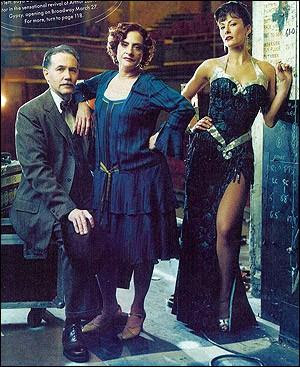Let it be known. I love Shirley Booth. Her films were too few and far between; and she is largely forgotten by many today save for those who remember the TV series Hazel. However, it should be Booth had an exemplary career onstage (from 1925-1970):
Liz Imbrie in the original company of The Philadelphia Story
Ruth Sherwood in the original company of My Sister Eileen
Bunny Watson in the original company of The Desk Set
Leona Samish in the original company of The Time of the Cuckoo
That isn’t even taking into consideration her musical theatre career which started with A Tree Grows in Brooklyn in 1951 (where she sings the classic “He Had Refinement” – the delivery on the cast album is so definitive you’ll never want to hear anyone else do it) and continued a downward spiral through By the Beautiful Sea and the flops Juno (a personal favorite) and Look to the Lilies.
The role for which she will be most regarded is that of Lola Delaney in William Inge‘s Come Back, Little Sheba. Booth created the part in the original Broadway production and would later recreate it for film opposite Burt Lancaster; she would become the first person to win the Tony and Oscar for the same role. Watching Booth is an unmitigated joy. A shining example of a character actress, Booth’s distinctively nasal voice, her radiating warmth and stellar range turns the film version of Sheba into an acting master class. (If you have not seen this film and are still reading this, you really should be on your way to Netflix now). Booth evokes that kind of soulful and loving reaction that is reserved mostly for beloved aunts and grandmothers. You know what I mean.
How do you describe Lola Delaney? In certain ways she reminds me of my mother: incredibly talkative, always friendly to everyone she meets and willing to talk about everything. That’s about where the similarities end. Lola is basically trapped in her marriage to Doc, her recovering alcoholic husband who is driven back to the bottle by the seemingly virginal boarder, Marie that lives with them. Marie’s a little ho. She adores the Delaney’s but she is carrying on with the muscular and lascivious Turk while all but engaged to another guy back home. She functions as a surrogate daughter for the childless Lola and Doc, but she also inadvertently wakes the demons surrounding their marriage. Basically, it’s as though they’ve settled, but Marie reminds them both of their lost youth and innocence in their own ways. By the play’s end, so much that has been left unspoken is – and as a couple must learn to cope and go on with their lives.
Not much happens, but it’s a marvel to behold. Especially by S. Epatha Merkerson in the Broadway revival. Lola is, aside from being charming and endearing, also a character of deceptive simplicity. She isn’t written with great histrionics of many other characters of the era, in fact there is an innate honesty in the way that Inge created his character. In fact many of her earthshattering moments are when she isn’t speaking at all. Merkerson’s performance is so genuine that you never felt you were watching an actress perform, but a lonely housewife managed to wander onstage and we became a part of her life, albeit for two hours. And more importantly, you never once would think you were looking at Anita van Buren, the formidable police lieutenant she’s portrayed on Law & Order for more than a decade.
There is a brilliantly constructed sequence in the first act that depicts Lola’s life after her husband has gone to work and Marie has left for school. In the first pause after she is alone, just the way she looks around the room while slowly rubbing her hands down her waist speaks inordinate volumes. Then she encounters the new mailman, whom she invites in for water and inundates with small talk. Similarly, she invites the milkman in as well immediately following. Both cases, she is desperate for kindness and kinship, the warmth and neediness that is there because Doc is complacent but emotionally distant. With the postman, she delivers a rapid-fire monologue just for the sake of conversation that leaves him wanting to leave; but the remnants of the coquettish flirt of her youth manage to win him over. Same for the milkman; whom she is even more successful for admiring his athletic physique. By the end of both brief sequences, she has won them over. This scene plays importance during the denouement where Lola is too distracted to see the mailman seal a letter and place it in the mailbox (a fulfillment of an early promise) or appreciate the milkman’s photo display in the health and fitness magazine. Yet it displays to the audience the kind of positive impact Lola’s innate goodness has on others. Not to mention how she befriended her next door neighbor Mrs. Coffman, whom at first she suspected of killing Sheba, but during the violent drunken climax, is first on hand to help Lola.
I’m loathe to reveal more of the plot since the piece isn’t quite the chestnut you’d expect. There are certain elements that could be considered archaic, but the play is unexpected in many ways. And for that, you should treat yourself to a quick read of the script, or better yet, watching the film adaptation.
The show was woefully a limited engagement (that closed on 3.16). If you got to see this actress at her peak, count yourself among the lucky. If you missed it, more’s the pity. Let’s hope S. Epatha Merkerson comes back to the boards as soon as possible.
